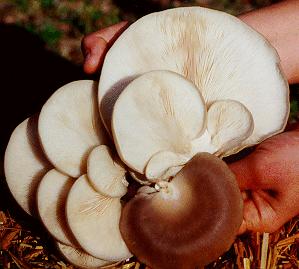Florida Oyster Mushrooms

The Florida Oyster Mushroom is technically known as P.ostreatus.....
P. ostreatus contains 8 kinds of amino acids, as well as Vitamin B1, B2, and P (Ying, 1987). One analysis revealed appreciable amounts of all essential amino acids with the exception of tryptophan and the protein quality was high enough to nearly equal animal-derived protein (Eden & Wuensch, 1991). Grown on wheat straw, P. ostreatus contains minerals (7.9%), crude fiber (12.0%), lipids (4.2%), protein (15.7%), and carbohydrates (54.4%) (Garcha, 1993). The main fatty acid in the fruit-body is oleic acid (Solomko, 1984), and the saturated to unsaturated fatty acid ratio is 14 (saturated) to 86 (unsaturated) (Bano & Rajarathnam, 1988). The major organic acids in the fruiting bodies include formic, malic, acetic (the most abundant at 266 mg/100 g), and citric acids (Id.).
There have been some rather encouraging results in the study of the effect that oyster mushrooms have on cancer. Antitumor activity of P. ostreatus as part of the normal diet was found in a feeding study of the mushroom in mice with sarcoma 180. The inhibition rate reached 79.4%, and against a mammary tumor system (MM-46) there was an 89.7% tumor inhibition rate (More, et al., 1986). By injection (i.p.), P. ostreatus (200 mg/kg/day X10) produced a 75.3% inhibition of tumors (Ikekawaa, 1969). An acidic polysaccharide fraction of this mushroom showed a 95% tumor inhibition rate against sarcoma 180 from doses of 5 mg/kg (Yoshioka, et al., 1972).
The dried and powdered mushroom fed to hamsters at 2% of a high-fat diet for 6 months lowered serum very low density lipoprotein (VLDL) in blood plasma, as well as cholesterol and triglycerol levels, in the liver more than in controls. Serum VLDL decreased by 65-80%, and total serum lipid levels were reduced by 40%. A polysaccharide from the mushroom as part (4%) of a normal diet was found to lower serum and liver levels of cholesterol accumulation by 45% in 3 months (Bobek, et al., 1993). Rats with hereditary high cholesterol levels also showed significantly reduced levels of serum cholesterol from feeding on the mushroom a part of the diet (4%). Even with 1% cholesterol added into their feed, these rats showed a nearly 40% decrease in cholesterol levels (VLDL and LDL) (Bobek, et al., 1991a). (There have been no clinical studies of this kind done on human beings.)
Oyster mushrooms may be an excellent blood-builder. According to published results, it has up to 19 mg/100 grams (dried) of iron. In animal feeding studies, the addition of oyster mushrooms to the diets of anemic albino rats raised hemoglobin content to 15.5 to 16.2, which compares with 8.2 for controls fed copper and milk. The oyster mushrooms used in this study were P. sajor-cajur and P. flabellatus.
In China, oyster mushrooms are used for joint and muscle relaxation (Yang & Jong, 1989); when the sopophores are made into "tendon-easing powder," they are effective in the treatment of lumbago, numbed limbs, and tendon and blood vessel discomfort.
In the Czech Republic, extracts have been made from oyster mushrooms as the main ingredient in dietary preparations recommended for prevention of high cholesterol (Opletal, 1993).
Although the different types of oyster mushroom are similar to some degree, some have properties that set them apart from other varieties. For instance, there is a variety called P. griseus, that contains a highly active antibacterial substance named "pleurotin." Some varieties of oyster mushrooms have more or less nutritional content than others, and some have not been fully studied yet.
Back to Main Page 

